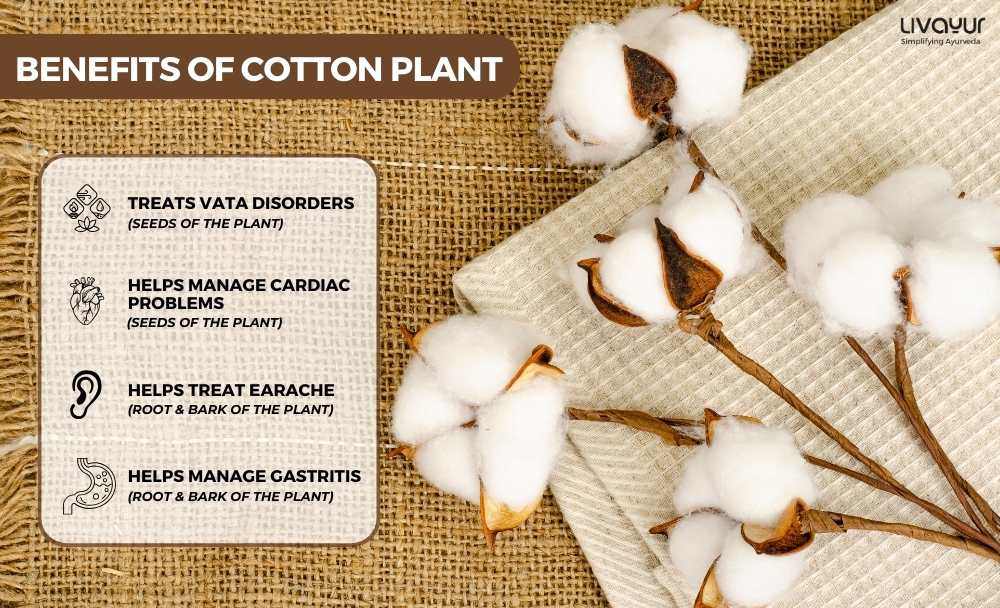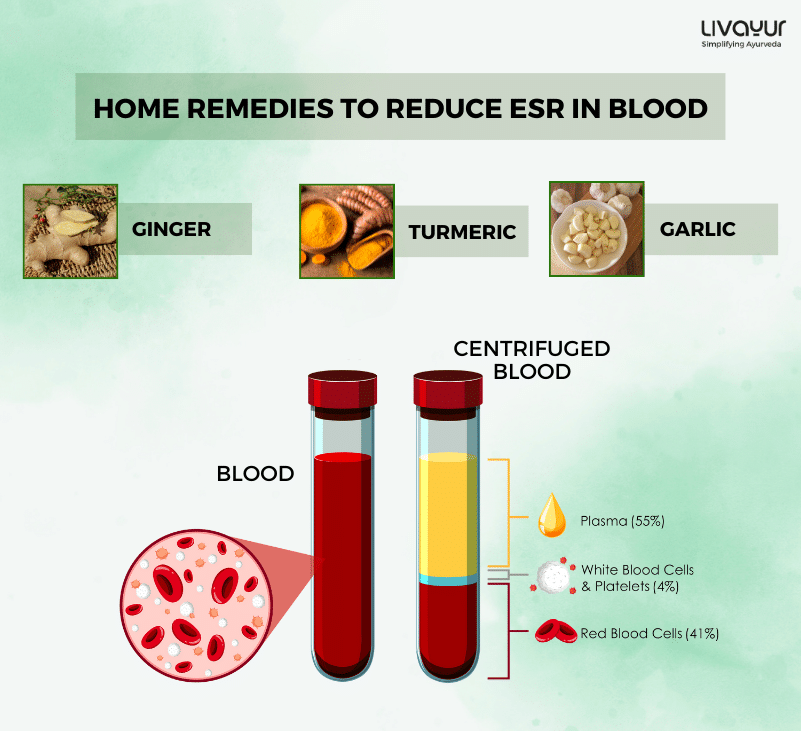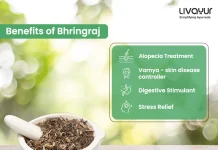
Ever wondered about the profound healing powers of the cotton plant in Ayurveda? Cotton harbors a treasure trove of medicinal properties from its roots to its fibers.
It is fascinating how cotton, dating back to ancient civilizations, maintains its significance as a crucial plant for humanity. Its multifaceted nature goes beyond its textile use, encompassing medicinal applications, pigment creation, derivatives for cattle feed, and versatile oil extracts. This range highlights its crucial role across life and industry, showcasing its significance throughout history. [1]Explore how this seemingly humble plant offers a spectrum of advantages and benefits of cotton plants, deeply rooted in the wisdom of ancient Ayurvedic practices.
Cotton in Ayurveda
Cotton plant flowers indeed possess various Ayurvedic properties that can be beneficial for health. The different parts of the cotton plant, such as the root bark and seeds, exhibit diverse tastes, potencies, and effects on the Doshas, according to Ayurveda.
Root Bark Properties:
Laghu and Theekshana: These properties indicate that the root bark is light to digest and has strong, piercing qualities.
Rasa (Taste): The taste of the cotton plant root bark is predominantly Katu or pungent, and it also contains Kashaya or astringent taste.
Veerya (Potency): The root bark is considered hot in potency.
Cotton Seeds Properties:
Cotton seed uses are many. The seeds exhibit Snigdha properties, meaning they are oily and unctuous.Veerya (Potency): The seeds are known to have a Sheeta or cooling effect.
Medicinal Effects:
Pacifying Doshas: The properties of the cotton plant, especially the root bark, are believed to be beneficial in pacifying Vata and Pitta Doshas in the body according to Ayurveda.
These properties and effects align with Ayurvedic principles where the tastes, potencies, and qualities of different plant parts are considered when prescribing them for health benefits. The root bark’s hot potency and pungent taste might be used in conditions where heating and stimulating effects are required, while the seeds’ cooling nature could be employed in situations that require cooling or soothing actions.
Benefits of Cotton Plant According to Ayurveda
Cotton Seeds
1. Respiratory Health:
Helps with respiratory problems like coughs and bronchitis due to expectorant qualities.
Infusions or decoctions from cotton seeds aid in clearing respiratory congestion and phlegm.
2. Anti-Inflammatory Properties:
Assists in reducing inflammation in conditions like arthritis, joint pain, and skin inflammations.
Applied as poultices or compresses to alleviate swelling and discomfort.
3. Wound Healing:
Cotton root extracts are recognized for their ability to promote wound healing.
Topically applied to wounds to facilitate healing and prevent infections.
4. Digestive Health:
Cottonseed oil, in small doses, promotes better digestion according to Ayurveda.
Has a mild laxative effect that facilitates smoother bowel movements.
5. Skincare:
Cottonseed oil’s emollient and hydrating qualities make it beneficial for dry, irritated skin.
Used in creams and lotions to soothe skin and provide hydration.
6. Menstrual Health:
Preparations from cotton roots are believed to ease menstrual discomfort and regulate menstrual cycles in certain traditional practices.
Root and Root Barks
7. Earache and Tinnitus:
Used in treatment for ear-related issues like earache and tinnitus.
8. Excessive Thirst:
Helpful in managing excessive thirst, according to Ayurveda.
9. Gastritis and Eye Disorders:
It alleviates burning sensations experienced in gastritis and some eye disorders.
Cotton Plant Leaves Medicinal Uses
10. Fever and Inflammation
Traditionally use of cotton leaves in some cultures includes its ability to lower fever and is also applied topically to reduce swelling and treat skin conditions.
Here’s a table showing the compounds in cotton plant and their health benefits
| Compounds | Biological Activity |
| 9-octadecenoic acid; (Z)-form | Insecticidal, anti-bacterial and fungicidal activity |
| tetradecanoic acid | Defoaming agent, flavour adjuvant used in food processing |
| Carbohydrates | |
| cellulose | Capsule and tablet diluent |
| Proteins | |
| 3-phosphoglycerate phosphatase | Enzyme activity |
| vicilin | Anti-hypertensive activity |
| caryophyllene | Anti-inflammatory effects, anti-microbial activity, regulation of cellular lipid metabolism, flavouring properties |
| farnesene | Anti-oxidant effects |
| humulene | Anti-inflammatory properties, aromatic properties and cytotoxic activity |
| bisabolol | Aromatic properties, anti-inflammatory effects, anti-carcinogenic activity, anti-microbial and anti-oxidative properties |
| caryophyllene oxide | Cytotoxic activity, phytogrowth inhibition, analgesic and anti-inflammatory activity |
| 3,10-dihydroxy-1,3,5,7-cadinatetraen-9-one | Phytoalexin, antifungal agent |
| β-sitosterol | Antimicrobial activity, anti-hypercholesteraemic and anti-inflammatory activity |
| strigol | Germination stimulant |
| 2,3,9-trihydroxy-1,3,5,7,9-cadinapentaen-14-al; 3-Me ether | Phytoalexin |
| 2,8,9-trihydroxy-1,3,5,7,9-cadinapentaen-14-al; 8-deoxy | Antifungal activity |
| Phenols | |
| chlorogenic acid | Anti-oxidant and anti-mutagenic activity |
| gallic acid | Antioxidant activity, cytotoxic activity |
| 4-hydroxybenzoic acid | Anti-microbial activity, used as preservative, oestrogenic activity, anti-inflammatory and anti-oxidant activity |
| gossypol; (+)-form | Contraceptive and hypokalemic activity |
| 3,3′,4′,5,7-pentahydroxyflavan; (2S,3R)-form | Cytotoxic and phytotoxic activity |
| 3,3′,4′,5,7-pentahydroxyflavone; 3′-O-β-d-glucopyranoside | Enzyme inhibitor, cytotoxic, antioxidant activity |
| scopoletin | Anti-spasmodic and anti-inflammatory activity |
| Fatty acids | |
| 11,14-eicosadienoic acid | Hormonal activity |
| hexadecanoic acid | Anti-microbial and anti-inflammatory activity |
| octadecanoic acid | Pharmaceutical excipient, surfactant, and softening activity |
| Terpenes | |
| camphene | Aromatic properties, antioxidants effects |
| limonene | Flavouring properties. gastro-protective effects, anti-cancer, and anti-inflammatory activity |
| myrcene | Analgesic effects, anti-microbial activity, anti-inflammatory activity, anti-catabolic activity |
| α and β-pinene | Gastro-protective effects, anti-microbial and anti-inflammatory effects |
| sabinene | Anti-microbial activity, anti-oxidant activity |
| α-thujene | Pungent activity |
Side Effects of Cotton Plant
1. Unsafe During Pregnancy:
Decoctions of cotton root bark may induce uterine contractions. Hence, they should be avoided during pregnancy.
2. Avoidance for Specific Groups:
Pregnancy: Not recommended due to potential uterine contractions.
Kidney Problems: Individuals with kidney issues should avoid consuming cotton seeds or root bark.
3. Using as birth control:
Men using cotton for birth control should understand that it might cause irreversible sterility.
Precautions for Safe Usage
1. Plant Identification:
Ensure the correct species of cotton plant is used, distinguishing textile-oriented species from those used for therapeutic purposes.
2. Consultation and Expert Advice:
Seek guidance from herbalists, botanists, or healthcare professionals well-versed in herbal medicine before using cotton plants medicinally.
3. Avoid Raw Consumption:
Raw cotton or cottonseed contains chemicals like gossypol that can be harmful if ingested.
4. Use Processed Forms:
Prefer processed forms like cottonseed oil, ensuring gossypol removal, especially when using it for medicinal purposes under expert supervision.
5. Dosage Caution:
Adhere strictly to recommended dosages prescribed by healthcare providers when using cotton-based therapies to avoid negative effects due to misuse or overuse.
6. Allergic Reaction Monitoring:
Be vigilant for allergic reactions when applying topically or consuming cotton derivatives, as some individuals may be sensitive to them.
7. Awareness of Potential Side Effects:
Recognize potential side effects, particularly related to gossypol present in certain parts of the plant. These effects may include male fertility issues and gastrointestinal problems.
8. Avoid during pregnancy:
Using cotton during pregnancy is considered unsafe due to its potential to cause uterine contractions, which could lead to a miscarriage. It is advised to avoid its use during this time.
9. Breastfeeding moms should avoid:
Inadequate information is available regarding the safety of cotton use for breastfeeding women. So, it is best to avoid it.
10. Avoid during specific health conditions:
Individuals with kidney problems or issues related to their reproductive system should refrain from using cotton due to potential adverse effects.
Dosage
Determining the appropriate dose of cotton or its derivatives for medicinal purposes can be complex and varies based on factors like age, health conditions, and other medications taken. As of now, scientific information regarding specific dosage ranges for cotton is insufficient.
It is highly essential to note that natural products, despite their perceived safety, may not always be without risks, and dosage plays a critical role. Following directions provided on product labels and seeking guidance from healthcare professionals, pharmacists, or physicians is crucial before using cotton or any natural product for therapeutic purposes.
Consulting with a healthcare professional helps ensure safety, appropriate dosing, and compatibility with existing health conditions or medications, mitigating potential risks associated with cotton derivatives.
Conclusion
The cotton plant, integral to Ayurvedic medicine, holds medicinal significance attributed to its root bark and seeds. Root bark, characterized by laghu and theekshana properties, aids in pacifying Vata and Pitta Doshas, while the seeds exhibit snigdha qualities. Medicinally, the benefits of cotton plants are immense as these components address various health concerns, from respiratory issues to inflammation and skincare. However, caution is advised, especially during pregnancy and for individuals with kidney or reproductive system problems.
FAQs
1. Which part of the cotton plant is used for medicinal purposes?
Medicinally, different components of the cotton plant are utilized: the root bark and seeds. The bark from the plant’s roots and the seeds themselves are employed in creating remedies. However, it is crucial to distinguish this from cottonseed extract containing gossypol, a compound with specific considerations and side effects.
2. How is the cotton bush useful?
The cotton bush is a versatile plant with various uses across its different parts. Its primary fiber is processed into yarn and fabric, forming the basis for textiles and clothing. The seeds serve multiple purposes: they are crushed to extract oil used in cooking and industry, and they’re also valuable as animal feed. Linters, the small fibers left on the seeds after ginning, find their way into products like cotton balls and have applications in medicine and cosmetics. Even the remaining plant material plays a role—it is often mulched or composted, returning nutrients to the soil and contributing to its fertility.
3. Which part of the cotton plant is most useful?
Every part of the cotton plant serves a purpose. However, the most widely recognized and crucial part is the fiber or lint derived from the cotton bolls. This fiber is the foundation for creating cotton cloth, one of the most prevalent and versatile materials used globally. The linters, which constitute the short fuzz on the seed, play a significant role. They provide cellulose, serving as a crucial ingredient in producing various items, including plastics, explosives, and numerous other products.
4. Which cotton is most commonly used?
Upland cotton (Gossypium hirsutum) stands out as the most commonly utilized type of cotton. Its popularity stems from its high yield and relatively easy cultivation process. Upland cotton accounts for approximately 90% of the world’s total cotton production, making it the predominant variety found in shops and used across various industries.
5. Can the cotton plant be consumed?
While various parts of the cotton plant have uses, the seeds are generally not considered safe for consumption due to the presence of a substance called gossypol. Gossypol acts as a defense mechanism for the cotton plant against insects, but it is considered a toxin for humans. It is found in the seeds and also in the plant’s leaves, contained within dark glands.
6. What are the uses of cotton plants as per Ayurveda?
According to Ayurveda, cotton plants are good for balancing the body’s Pitta and Vata doshas.
Disclaimer:
This article is written from a health and wellness perspective and is not medical advice.
Kindly seek the help of a certified medical practitioner before initiating any treatment.




















